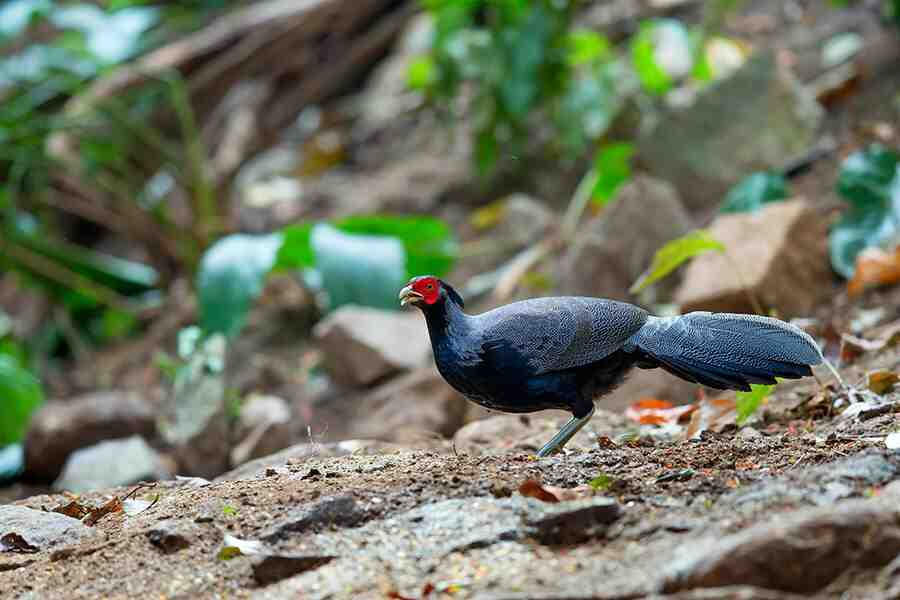Lophura leucomelanos
IUCN
LCBasic Information
Scientific classification
- name:Lophura leucomelanos
- Scientific Name:Pheasant, black chicken,Lophura leucomelanos,Kalij Pheasant
- Outline:Landfowl
- Family:Galliformes Phasianidae Pheasant
Vital signs
- length:56.5-60cm
- Weight:770-1600g
- lifetime:No verification information
Feature
In fact, she is not black at all
Distribution and Habitat
The black pheasant is distributed in Yunnan and Tibet in southwest China, as well as northern India, Myanmar, Thailand, Nepal, Bhutan, Pakistan, Kashmir and other countries and regions.
The black pheasant is only found in mountain forests at an altitude of 2,300-3,300 meters, and sometimes in the arrow bamboo bushes and forest grass in the low mountains and valleys. It is also commonly found in low mountains, hills and valleys.
Appearance
The male black pheasant is purple-black from the top of the head to the back of the neck and the sides of the neck. It has a long and slightly straight feather crest on the head, which is blue-black with purple luster; the back is blue-black with purple luster, and the feather edges are slightly worse; the outer part of the primary flight feathers is smooth. The feather stems are brown, and the inner quills are darker; the lower back, waist and upper tail coverts are dark blue with white terminal spots and narrow blue-black sub-terminal spots; the tail is also blue-black, but the purple luster is poor. The face is naked and red, with a few black feathers on the cover. The lower body is mostly dark brown, and the breast feathers are lanceolate. The color is white except for the base of the feathers, which is stained with gray. The upper body of the female bird is mostly reddish brown, with light gray feather edges. The lower body is similar to the upper body, but lighter. The middle par
Details
The black pheasant is called Kalij Pheasant in foreign language, and it is divided into 9 subspecies. There are 2 subspecies in China. The nominate subspecies is distributed in Nyalam, Jilong, Yadong and other places in southern Tibet; the southern Tibetan subspecies is distributed in Medog, Zayu, Bomi in southeastern Tibet and Yingjiang, Gongshan and other places in northwestern Yunnan.

Black pheasants always move in pairs or family groups. They usually start to move around 5 a.m. and stop around 7 p.m. They are most active in the morning and dusk, and less active at noon. They often roost in trees at night. They often move along fixed routes, and over time, they often form obvious "bird trails". When active, they often walk with their heads held high and move alertly. When startled, they run quickly, with their crests erect and tail feathers slightly spread. After running a certain distance, they will observe the movements alertly, sometimes walking and stopping, and looking around. In addition to being good at walking and running on the ground, they can also fly and jump. When jumping, they flap their wings as an aid, but sometimes they don't spread their wings. When running fast, their heads shake back and forth, and their tail feathers droop slightly. They mainly feed on young leaves, buds and seeds of plants, and also eat some insects.
The call of the black pheasant: The call of the flock of birds when they disperse is a low kurr-kurr-kurrchi-kurr sound. The call of the male bird is a loud whistle accompanied by the sound of the wings flapping. The fighting call is a threatening koor koor sound followed by a sharp waak, waak sound. The alarm is a repetitive koorchi koorchi koorchi call or a guttural whoop-keet-keet sound.
The breeding season of the black pheasant is from May to June. Each nest lays 5-9 eggs, up to 15 eggs, and the eggs are dark yellow-pink in color. The incubation period is 24-25 days.
In nature, the survival ability of the black pheasant is still relatively strong. They usually only move and go out to forage in the morning and evening, and hide and rest at other times. The flying ability of the black pheasant is relatively average, but it can run and jump on land. It is not easy for even the best "hunters" in nature to hunt them.
There are not many black pheasants, with only about 770 in Pakistan, and less than 1,000 in the southern Tibet subspecies in China, and even less than 100 in the nominate subspecies.
Listed as a national key protected animal in China: Level 2
Listed in the 2012 Red List of Endangered Species of the World Conservation Union (IUCN) ver 3.1 - Least Concern (LC).
Protect wild animals and stop eating game.
Maintaining ecological balance is everyone's responsibility!








